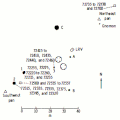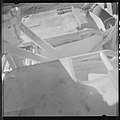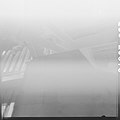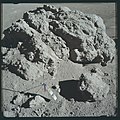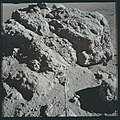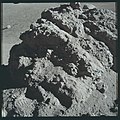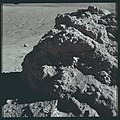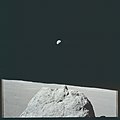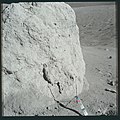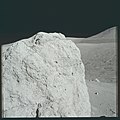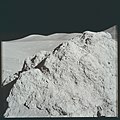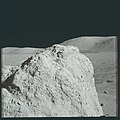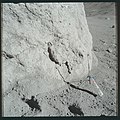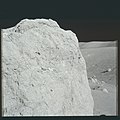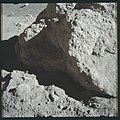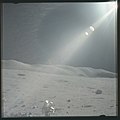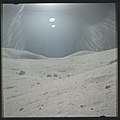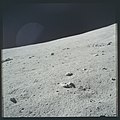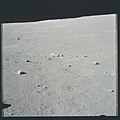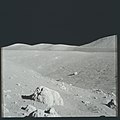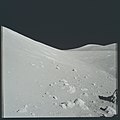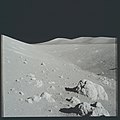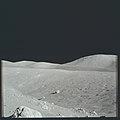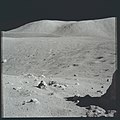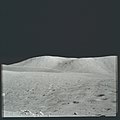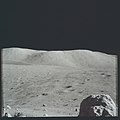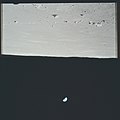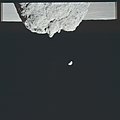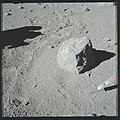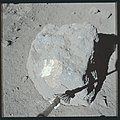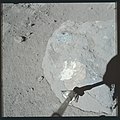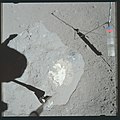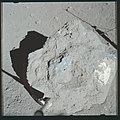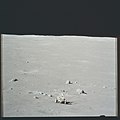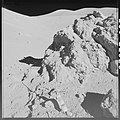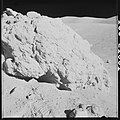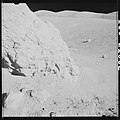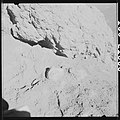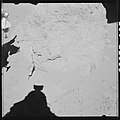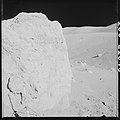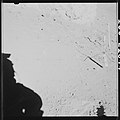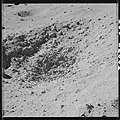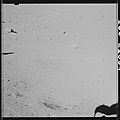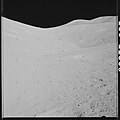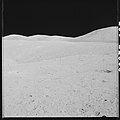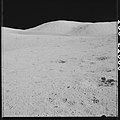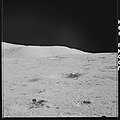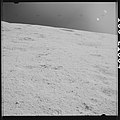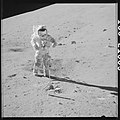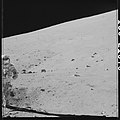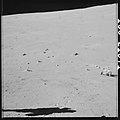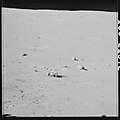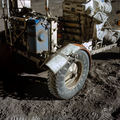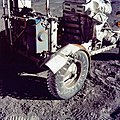Category:Apollo 17 EVA at Station 2

From the Apollo 17 Preliminary Science Report, Chapter 5 (NASA SP-330, 1973):
The South Massif
The rocks of the South Massif constituted the prime geological objective on the mission to the Taurus-Littrow valley, although the long traverse to the South Massif clearly taxed the operational limits of our surface exploration capabilities. An hour-long trip to the edge of Nansen Crater at the base of the massif, for approximately 60 min of exploration time there, meant that the remainder of this excursion would be extremely limited in time available for exploration. The boulders that were our specific objectives held the promise of an unparalleled view into the history of the lunar crust. Although overshadowed by more spectacular later discoveries, we were not to be disappointed by "old station 2."
The most obvious sources for the boulders near station 2 are on the upper one-fourth of the South Massif slope. Visual inspection from a distance indicated that linear source-crops on this part of the massif and subtle linear color variations of blue-gray lying over tan-gray have an apparent dip of 10° to 15° toward the west. Offsets of the color changes, downward to the east, suggest that normal faults dipping steeply eastward cut the massif structure.
The boulders investigated at station 2 included crystalline, tan-gray matrix-rich breccia and blue-gray matrix-rich breccia, but no contact relations were observed. The tan-gray breccia is less vesicular and more heterogeneous in texture than its North Massif counterpart. The sampled blue-gray breccia is similar to that found in the contact zones of the North Massif boulders. From a distance, boulders of both these rock types have a tan -gray hue very similar to that of the materials below the blue-gray tones in the high portions of the South Massif.
The distinctive clasts of contrasting shades and hues in the tan-gray and blue-gray breccias of the South Massif generally appear similar to those in the North Massif breccias. However, one crystalline clast in the boulder of blue-gray matrix-rich breccia has proved to be composed largely of olivine. The preliminary examination of rocks from both the South and North Massifs also suggests that various crystalline mafic rocks and some ultramafic rocks make up a significant portion of the distinctive clast population.
The third boulder examined at station 2 was a strongly foliated and layered fragment-rich breccia that is much less coherent than either the tan-gray or blue-gray breccia types. This foliated and layered breccia contains large clasts of both dark- and light-colored older breccias in a generally light-colored matrix. There are also small clasts with distinctive dark coronas around them. From a distance, this boulder has a blue-gray hue very similar to that of the blue-gray materials observed near the top of the western portion of the South Massif.
Along the boundary between the South Massif and the valley floor, there is a trough. This trough is much broader and more continuous than had been apparent before the mission. The trough is a few hundred meters wide at station 2, is flat floored, and seems to include the crater Nansen as an integral, although much deeper, topographic unit.
The observed properties of the talus material at the base of the South Massif are very similar to those observed at the North Massif. In Nansen Crater, it is also clear that at least some of the South Massif talus forms a younger toe of debris over the valley floor, particularly over the light mantle deposits present in Nansen.
Media in category "Apollo 17 EVA at Station 2"
The following 138 files are in this category, out of 138 total.
-
A17 PSR Figure 6-105 Station 2.gif 350 × 350; 11 KB
-
AS17-135-20677 (21498896919).jpg 4,175 × 4,175; 4.26 MB
-
AS17-135-20678 (21497890918).jpg 4,175 × 4,175; 4.21 MB
-
AS17-135-20679 (21064729943).jpg 4,175 × 4,175; 5.59 MB
-
AS17-137-20900 (21684395135).jpg 4,175 × 4,175; 7.61 MB
-
AS17-137-20901 (21496466460).jpg 4,175 × 4,175; 7.4 MB
-
AS17-137-20902 (21063409833).jpg 4,175 × 4,175; 6.55 MB
-
AS17-137-20903 (21684393955).jpg 4,175 × 4,175; 7.58 MB
-
AS17-137-20904 (21061713274).jpg 4,175 × 4,175; 7.94 MB
-
AS17-137-20905 (21063378893).jpg 4,175 × 4,175; 7.94 MB
-
AS17-137-20906 (21658331276).jpg 4,175 × 4,175; 8.47 MB
-
AS17-137-20907 (21061712694).jpg 4,175 × 4,175; 8.32 MB
-
AS17-137-20908 (21496560788).jpg 4,175 × 4,175; 7.59 MB
-
AS17-137-20909 (21497572629).jpg 4,175 × 4,175; 7.07 MB
-
AS17-137-20910 (21061711584).jpg 4,175 × 4,175; 8.13 MB
-
AS17-137-20911 (21061711174).jpg 4,175 × 4,175; 9.22 MB
-
AS17-137-20912 (21063407003).jpg 4,175 × 4,175; 6.57 MB
-
AS17-137-20913 (21061710504).jpg 4,175 × 4,175; 6.1 MB
-
AS17-137-20914 (21496462490).jpg 4,175 × 4,175; 5.78 MB
-
AS17-137-20915 (21061709814).jpg 4,175 × 4,175; 5.73 MB
-
AS17-137-20916 (21061709454).jpg 4,175 × 4,175; 6.67 MB
-
AS17-137-20917 (21672965802).jpg 4,175 × 4,175; 6.86 MB
-
AS17-137-20918 (21496461270).jpg 4,175 × 4,175; 7.18 MB
-
AS17-137-20919 (21496557088).jpg 4,175 × 4,175; 7.26 MB
-
AS17-137-20920 (21497568589).jpg 4,175 × 4,175; 7.05 MB
-
AS17-137-20921 (21496556038).jpg 4,175 × 4,175; 7.77 MB
-
AS17-137-20922 (21684387445).jpg 4,175 × 4,175; 5.93 MB
-
AS17-137-20923 (21496554988).jpg 4,175 × 4,175; 6.45 MB
-
AS17-137-20924 (21672962012).jpg 4,175 × 4,175; 7 MB
-
AS17-137-20925 (21496436020).jpg 4,175 × 4,175; 7.27 MB
-
AS17-137-20926 (21497565839).jpg 4,175 × 4,175; 5.56 MB
-
AS17-137-20927 (21496553088).jpg 4,175 × 4,175; 4.09 MB
-
AS17-137-20928 (21672960772).jpg 4,175 × 4,175; 4.58 MB
-
AS17-137-20929 (21496552208).jpg 4,175 × 4,175; 4.58 MB
-
AS17-137-20930 (21063399373).jpg 4,175 × 4,175; 6.07 MB
-
AS17-137-20931 (21063399253).jpg 4,175 × 4,175; 7.82 MB
-
AS17-137-20932 (21693585731).jpg 4,175 × 4,175; 7.13 MB
-
AS17-137-20933 (21063398843).jpg 4,175 × 4,175; 5.68 MB
-
AS17-137-20934 (21497563739).jpg 4,175 × 4,175; 6.55 MB
-
AS17-137-20935 (21061703074).jpg 4,175 × 4,175; 5.18 MB
-
AS17-137-20936 (21063398283).jpg 4,175 × 4,175; 5.43 MB
-
AS17-137-20937 (21496550508).jpg 4,175 × 4,175; 6.19 MB
-
AS17-137-20938 (21497563029).jpg 4,175 × 4,175; 6.74 MB
-
AS17-137-20939 (21672958532).jpg 4,175 × 4,175; 6.84 MB
-
AS17-137-20940 (21061702254).jpg 4,175 × 4,175; 8.32 MB
-
AS17-137-20941 (21693584081).jpg 4,175 × 4,175; 7.73 MB
-
AS17-137-20942 (21063397113).jpg 4,175 × 4,175; 6.27 MB
-
AS17-137-20943 (21063396963).jpg 4,175 × 4,175; 8.26 MB
-
AS17-137-20944 (21496453740).jpg 4,175 × 4,175; 8.35 MB
-
AS17-137-20945 (21693583071).jpg 4,175 × 4,175; 6.84 MB
-
AS17-137-20946 (21693582831).jpg 4,175 × 4,175; 8.92 MB
-
AS17-137-20947 (21063396163).jpg 4,175 × 4,175; 6.5 MB
-
AS17-137-20948 (21693582451).jpg 4,175 × 4,175; 9.93 MB
-
AS17-137-20949 (21061683434).jpg 4,175 × 4,175; 7.05 MB
-
AS17-137-20950 (21658318166).jpg 4,175 × 4,175; 9.6 MB
-
AS17-137-20951 (21496547808).jpg 4,175 × 4,175; 7.23 MB
-
AS17-137-20952 (21672955792).jpg 4,175 × 4,175; 9.08 MB
-
AS17-137-20953 (21061699314).jpg 4,175 × 4,175; 7.07 MB
-
AS17-137-20954 (21684379145).jpg 4,175 × 4,175; 8.87 MB
-
AS17-137-20955 (21063393963).jpg 4,175 × 4,175; 7 MB
-
AS17-137-20956 (21684378775).jpg 4,175 × 4,175; 8.15 MB
-
AS17-137-20957 (21061698344).jpg 4,175 × 4,175; 9.13 MB
-
AS17-137-20958 (21497558359).jpg 4,175 × 4,175; 11.46 MB
-
AS17-137-20959 (21497558009).jpg 4,175 × 4,175; 10.84 MB
-
AS17-137-20960 (21693579291).jpg 4,175 × 4,175; 10.05 MB
-
AS17-137-20961 (21658315186).jpg 4,175 × 4,175; 10.88 MB
-
AS17-137-20962 (21693578661).jpg 4,175 × 4,175; 5.94 MB
-
AS17-137-20963 (21061696664).jpg 4,175 × 4,175; 6.08 MB
-
AS17-137-20964 (21063391613).jpg 4,175 × 4,175; 6.62 MB
-
AS17-137-20965 (21658314116).jpg 4,175 × 4,175; 6.32 MB
-
AS17-137-20966 (21497556089).jpg 4,175 × 4,175; 5.8 MB
-
AS17-137-20967 (21684375645).jpg 4,175 × 4,175; 5.62 MB
-
AS17-137-20968 (21658313686).jpg 4,175 × 4,175; 5.39 MB
-
AS17-137-20969 (21063390693).jpg 4,175 × 4,175; 5.33 MB
-
AS17-137-20970 (21658313286).jpg 4,175 × 4,175; 5.2 MB
-
AS17-137-20971 (21672951492).jpg 4,175 × 4,175; 5.27 MB
-
AS17-137-20972 (21063390423).jpg 4,175 × 4,175; 5.56 MB
-
AS17-137-20973 (21063390313).jpg 4,175 × 4,175; 5.84 MB
-
AS17-137-20974 (21497555109).jpg 4,175 × 4,175; 6.67 MB
-
AS17-137-20975 (21658312476).jpg 4,175 × 4,175; 6.81 MB
-
AS17-137-20976 (21672950642).jpg 4,175 × 4,175; 5.43 MB
-
AS17-137-20977 (21061682524).jpg 4,175 × 4,175; 7.01 MB
-
AS17-137-20977 annotated.jpg 964 × 782; 205 KB
-
AS17-137-20978 (21496542588).jpg 4,175 × 4,175; 7.05 MB
-
AS17-137-20979 (21672950192).jpg 4,175 × 4,175; 6.66 MB
-
AS17-137-20979.jpg 3,879 × 3,879; 13.66 MB
-
AS17-138-21029 (21064161253).jpg 4,175 × 4,175; 4.89 MB
-
AS17-138-21030 (21694350031).jpg 4,175 × 4,175; 4.69 MB
-
AS17-138-21031 (21498327959).jpg 4,175 × 4,175; 4.88 MB
-
AS17-138-21032 (21694349601).jpg 4,175 × 4,175; 4.8 MB
-
AS17-138-21033 (21064132893).jpg 4,175 × 4,175; 4.63 MB
-
AS17-138-21034 (21498327469).jpg 4,175 × 4,175; 4.8 MB
-
AS17-138-21035 (21497317558).jpg 4,175 × 4,175; 4.91 MB
-
AS17-138-21036 (21064159823).jpg 4,175 × 4,175; 4.68 MB
-
AS17-138-21037 (21659088946).jpg 4,175 × 4,175; 4.73 MB
-
AS17-138-21038 (21694348741).jpg 4,175 × 4,175; 4.73 MB
-
AS17-138-21039 (21497218020).jpg 4,175 × 4,175; 4.83 MB
-
AS17-138-21040 (21659088316).jpg 4,175 × 4,175; 4.57 MB
-
AS17-138-21041 (21062467184).jpg 4,175 × 4,175; 4.76 MB
-
AS17-138-21042 (21685143455).jpg 4,175 × 4,175; 4.94 MB
-
AS17-138-21043 (21673693422).jpg 4,175 × 4,175; 4.71 MB
-
AS17-138-21044 (21498325599).jpg 4,175 × 4,175; 4.55 MB
-
AS17-138-21045 (21064158223).jpg 4,175 × 4,175; 4.81 MB
-
AS17-138-21046 (21498325329).jpg 4,175 × 4,175; 4.88 MB
-
AS17-138-21047 (21497216960).jpg 4,175 × 4,175; 4.85 MB
-
AS17-138-21048 (21498324929).jpg 4,175 × 4,175; 5.05 MB
-
AS17-138-21049 (21497216400).jpg 4,175 × 4,175; 4.6 MB
-
AS17-138-21050 (21659086366).jpg 4,175 × 4,175; 4.97 MB
-
AS17-138-21051 (21659060926).jpg 4,175 × 4,175; 4.96 MB
-
AS17-138-21052 (21694345831).jpg 4,175 × 4,175; 5.12 MB
-
AS17-138-21053 (21685141335).jpg 4,175 × 4,175; 4.43 MB
-
AS17-138-21054 (21694345521).jpg 4,175 × 4,175; 4.78 MB
-
AS17-138-21055 (21062464504).jpg 4,175 × 4,175; 4.41 MB
-
AS17-138-21056 (21498323219).jpg 4,175 × 4,175; 4.39 MB
-
AS17-138-21057 (21062438004).jpg 4,175 × 4,175; 4.44 MB
-
AS17-138-21058 (21497313398).jpg 4,175 × 4,175; 4.55 MB
-
AS17-138-21059 (21673716782).jpg 4,175 × 4,175; 4.67 MB
-
AS17-138-21060 (21062463904).jpg 4,175 × 4,175; 4.62 MB
-
AS17-138-21061 (21062463504).jpg 4,175 × 4,175; 4.69 MB
-
AS17-138-21062 (21064154953).jpg 4,175 × 4,175; 4.55 MB
-
AS17-138-21063 (21062463114).jpg 4,175 × 4,175; 4.66 MB
-
AS17-138-21064 (21659084416).jpg 4,175 × 4,175; 4.6 MB
-
AS17-138-21065 (21694343751).jpg 4,175 × 4,175; 4.59 MB
-
AS17-138-21066 (21497213420).jpg 4,175 × 4,175; 4.53 MB
-
AS17-138-21067 (21659083826).jpg 4,175 × 4,175; 4.54 MB
-
AS17-138-21068 (21659083686).jpg 4,175 × 4,175; 4.52 MB
-
AS17-138-21069 (21659060446).jpg 4,175 × 4,175; 4.72 MB
-
AS17-138-21070 (21498321069).jpg 4,175 × 4,175; 4.78 MB
-
AS17-138-21071 (21673714752).jpg 4,175 × 4,175; 4.53 MB
-
AS17-138-21072 (21659083166).jpg 4,175 × 4,175; 4.66 MB
-
AS17-138-21073 (21694342711).jpg 4,175 × 4,175; 4.49 MB
-
AS17-138-21074 (21497310688).jpg 4,175 × 4,175; 4.66 MB
-
Duct tape apollo17.jpg 900 × 898; 307 KB
-
Nansen crater AS17-137-20942-47-49-55.jpg 1,410 × 494; 113 KB
-
Nansen crater AS17-P-2750 ASU.jpg 480 × 480; 47 KB
-
Nansen crater location AS17-151-23251.jpg 296 × 290; 48 KB
-
The Map & Tape Fender - Apollo 17.png 2,048 × 2,047; 18.69 MB
-
USGS in Spaaaaace!.jpg 2,000 × 1,995; 2.87 MB
